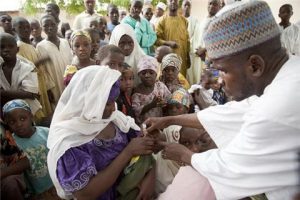Economic benefits of the Global Polio Eradication Initiative estimated at US$40-50 billion
New study in Vaccine offers strong economic justification for finishing the job on polio as quickly as possible.

Global Health Strategies
A new study being released this week estimates that the global initiative to eradicate polio could provide net benefits of at least US$40-50 billion if transmission of wild polioviruses is interrupted within the next five years. The study provides the first rigorous evaluation of the benefits and costs of the Global Polio Eradication Initiative (GPEI)—the single largest project ever undertaken by the global health community. The study comes at a crucial time—following an outbreak in the Republic of the Congo and one in Tajikistan earlier this year—that highlight the risk of delays in finishing the job on polio.
Published in the journal Vaccine, the study, “Economic Analysis of the Global Polio Eradication Initiative,” considers investments made since the GPEI was formed in 1988 and those anticipated through 2035. Over this time period, the GPEI’s efforts will prevent more than 8 million cases of paralytic polio in children. This translates into billions of dollars saved from reduced treatment costs and gains in productivity.
The study also reported that “add-on” GPEI efforts improve health benefits and lead to even greater economic gains during the same time period. Notably, it estimates an additional $17-90 billion in benefits from life saving effects of delivering vitamin A supplements, which the GPEI has supplied alongside polio vaccines.
“Polio eradication is a good deal, from both a humanitarian and an economic perspective,” said Dr. Radboud Duintjer Tebbens of Kid Risk, Inc., the lead author of the study. “The GPEI prevents devastating paralysis and death in children and also allows developing countries and the world to realize meaningful financial benefits.”
According to the study, although delays in achieving eradication are costly, even with delays, the GPEI still generates positive net economic benefit estimates.
“Investing now to eradicate polio is an economic imperative, as well as a moral one,” said Dr. Tachi Yamada, president of the Bill & Melinda Gates Foundation’s Global Health Program. “This study presents a clear case for fully and immediately funding global polio eradication, and ensuring that children everywhere, rich and poor, are protected from this devastating disease.”
The GPEI successfully reduced the global incidence of polio by 99 percent since 1988 and eradicated type 2 wild polioviruses in 1999. Intense efforts are underway to stop transmission of types 1 and 3 completely within the next several years, with indigenous transmission remaining only in relatively small areas in Afghanistan, India, Nigeria, and Pakistan and re-established transmission in a few countries, including Angola and the DRC. Until eradication occurs, all countries remain at risk for importation of the virus, as demonstrated by the 2010 polio outbreaks in Tajikistan and the Republic of the Congo. Congo’s recent outbreak has resulted in more than 200 cases of acute flaccid paralysis (AFP) since October, mostly affecting people older than 15.
“Studies like this help people put numbers on the value of prevention,” said Dr. Kimberly Thompson of Kid Risk, senior author of the study. Nobody questions the value of eradication in developed countries where polio is fortunately just a fading memory, but according to Thompson, “prevention activities like vaccination often go unappreciated, because it is difficult to count cases of a disease that do not occur.” The study provides an example of the real value that comes from international cooperation and investment in the health and development of children.
The study examined the 104 countries that directly benefit from the GPEI, which include predominantly lower-income countries. Many higher-income countries eliminated wild polioviruses before the GPEI began. Thus, the estimated net benefits in the study do not include the substantial benefits already accruing in developed countries.
The study was led by Kid Risk, Inc., an independent non-profit organization started in 2009 as the successor to the Kids Risk Project at the Harvard School of Public Health. Other research partners included the U.S. Centers for Disease Control and Prevention (CDC), Delft University of Technology, and the Global Polio Eradication Initiative. The CDC provided support for the study under a contract to the Harvard School of Public Health.
GPEI is a public-private partnership led by national governments, spearheaded by the World Health Organization, Rotary International, the CDC, and the United Nations Children’s Fund (UNICEF) and supported by organizations including the Bill & Melinda Gates Foundation.













